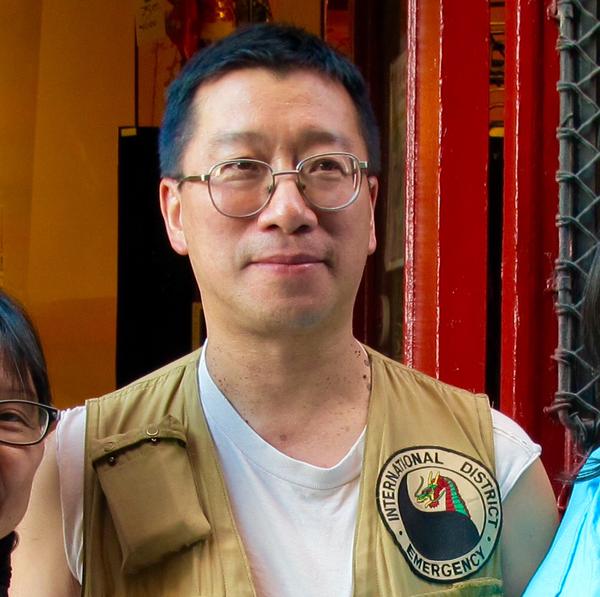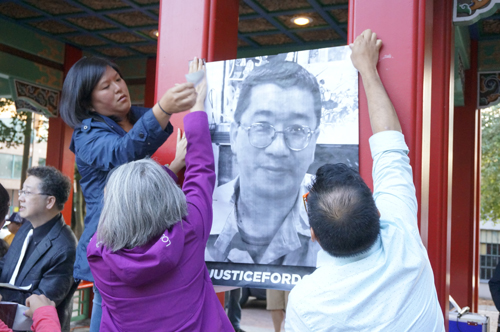By Carolyn Bick
NORTHWEST ASIAN WEEKLY
Editor’s Note: This is the third story in a three-part series marking 10 years since the death of Donnie Chin. Through the voices of those who knew him, this series explores his life, impact, and the legacy he left behind.
See Part 1 here and Part 2 here.

Donnie Chin
Ten years after the tragic loss of Donnie Chin, the Chinatown-International District (CID) activist and longtime leader of the International District Emergency Center (IDEC), the impact of his work continues to resonate deeply within the community.
Jamie Lee, co-executive director of the Seattle Chinatown International District Preservation and Development Authority (SCIDpda), had only one year to work alongside Donnie before he was shot and killed. Yet in that brief time, the two forged a close partnership focused on community safety and emergency preparedness.
In this final installment, Lee reflects on their shared efforts, the enduring influence Donnie holds over the neighborhood, and the challenges of carrying forward his legacy in today’s changing CID.
Jamie Lee
I met Donnie in 2014—so, just one year before he died.
I was overseeing the work that SCIDpda did around public safety, and specifically that year, we were working on an emergency preparedness training. That’s really how I got to know him.
I first met [Donnie] at an alley party in Canton Alley my first week on a job. And then, obviously, a summer later, a year later, he was murdered. And since then, I’ve continued to be involved in his organization, IDEC. I currently serve as the board chair.
He is a very memorable person. He’s a very matter-of-fact type of guy, very straightforward.
When people came to him, he kind of sizes them up to try to figure out how long they’re going to be around. And for lack of a better word, Donnie and I hit it off from the beginning. We started joking almost immediately. The person that was in my role before me also knew him quite well.
In addition to working on safety stuff at the time, we were also working on raising money and working on repaving Canton Alley, so we talked with Donnie about that stuff as well.
We worked on that stuff together and then he also would host these barbecues in the alley, just for people to meet each other. And then he always sent out weekly email reports of what’s going on in the neighborhood. I was on that list.
It’s kind of strange to think that I only knew him for like a year. So many people knew him for decades. But I definitely very distinctly remember it feeling like we were in the neighborhood together working on a team.
[My work with Donnie and IDEC] was definitely a lot of the emergency preparedness stuff. We were working specifically with the city—I think it was the office of emergency management.SCIDpda manages a number of buildings in this neighborhood. We also reached out to other building owners to think about how they would prepare our residents, who are non-English speaking, for a disaster. We worked on that for quite a few months. It was partially coming up with plans and thinking about what equipment to have in the building, and then how you would communicate that with residents.
We were doing that together. It was just overall types of public safety things that were happening in the neighborhood at the time. I think at the time, there was kind of a large encampment, and there were some concerns around drug activity and then around some late night activities. It ended up being unsafe.
[Donnie] worked with one of my staff members that was working on public safety as well. It wasn’t only that one project, but everything else was communication and the overall neighborhood connecting around issues. [Donnie’s] death was a pretty pivotal moment in my career in the neighborhood.I’ve worked [at SCIDpda] for 11 years, but at the time, I’d been there for a year. We were one of the first organizations to hear about it, because it was our staff—he was shot outside one of our buildings.
Our residents, our staff heard it. And so it ended up being our organization that broke the news to the larger community. I didn’t know what I was doing.
I was in my early 30’s, and just figuring it out as it goes. That day will forever kind of be in my memory.
From that day, I met a couple of people, one of which is his sister, [Connie]. Connie and I are close now. I also got closer with Dicky Mar at that point. I met him like maybe once before that. Then Kerry Taniguchi, who has since passed on.
I guess my point is that a lot of the relationships I have today grew out of that tragedy. And in some ways, it’s what Donnie would have wanted.
Connie says something really kind of meaningful, where she talks about how people always want to talk about how he died and really what we’re trying to carry on in IDEC is how he lived. That’s what she really wants to put forward.
In the time after his passing, there were quite a few things that happened. It directly impacted my work. It impacted how we address public safety, how we work in the city of Seattle. I started growing personal relationships with folks that were involved with the center and with him, because I think we just, for lack of a better word, bonded over that trauma. A bond is him, but it’s really a love for the neighborhood and this desire to see it thrive and to continue to be safe and continue to be kind of the home that all drew us there.
Donnie was the only staff member ever for the center. Now it has no staff. [Now it’s a board.]
We did a strategic planning process maybe three, four years ago, because we recognized that our membership was getting older and aging. We decided to focus on three areas. One was to continue to spread the word, in some ways, of what Donnie really wanted for the neighborhood and his story. And then two, to offer first aid assistance at community events, which we still do today. They are all volunteer-run. And the third was to help educate the community.
We used to offer first aid training, which we also still do today. [Donnie] did patrols and things like that, and we realized that’s not the thing that we want, that anybody wants to do right now, or that we feel like is appropriate for this time.
So we really narrowed it down to those three things to continue working on. And it’s a struggle, I’m going to be honest. It’s a bunch of people that have tons of jobs that they are trying to do on the side. Half of the board is working. The other half is retired, barely checking their email. We have to be in-person, otherwise nobody shows up. Because three or four of us are working right now and we’re still kind of in the middle of our careers, we’ve kind of divvied up tasks of who takes care of what so that it’s not all one person. It’s pumping along right now.
I think that there’s a lot of folks in the community that would like funding to go to IDEC to do certain things, but we don’t have the capacity for that right now. We have to be intentional about what we do.

Photo by George Liu/NWAW
The ongoing work of IDEC
When Donnie was still alive, he took in a lot of the kids in the neighborhood, like the latchkey kids, and he would have them come help out with what he was doing in the training and first aid. Now, some of them have grown up and become doctors and nurses and things like that. We are also trying to recruit more younger folks for our membership.
There are two kinds of ways to get involved in that. You can be a member, which means that you have to get first aid training and then you will staff our first aid station when we’re at community events. Or, you can be on our board—like, nobody would want me at a first aid station. [Laughs] There’s some people on the board that are appropriate for both.
We’re really trying to do [this] so that the work can continue on, recognizing that our membership has been aging.
I’d say there’s probably 50 people [in IDEC right now]. The active members that actually show up over our events is probably around 10–15, and I’d say probably about a third of those are younger.
Anytime you would see an emergency in the neighborhood, he was always the first guy there. He could run pretty fast. I’d be at a cafe and I’d see him run by, and you’d be like, “Oh, something’s going on.” He wore a radio that was tapped into the fire radio or whatever it’s called. So that was always kind of funny.
One time I showed up, he looked at me and he’s like, “What are you going to do?” And I was like, “What are you going to do?”
He would always do this funny thing where, one year, for some reason, we hired a lot of new people [at SCIDpda]. So I’d bring people—that was kind of your orientation in the neighborhood at the time. You get hired, you get a tour, and then you go meet Donnie.
And I’d bring people by and he’d be like, “Who’s first in line to cook? Are they going to cook for us?”
He would just make jokes like that. And it’s funny, if you go into Sun Mae now, Connie keeps the store up. But she keeps it way, way more tidy and cleaner than he ever did. And you used to walk in there and you knew he was in there because it was open.
So, you would shout his name out and you’d hear him before you see him, ‘cause he’d come out of like a pile or something and be like, “Hey, what’s up?”
It’s just little things like that.
He always had a joke. You would try to have a serious conversation and then he’d say a joke and then he’d get super serious. And you always knew when he was really serious because he wouldn’t joke at all.
He always wore tan—his whole vest thing going on.
We understood each other as down for the community and that was always kind of nice. We got each other.
He was a really particular person, kind of picky. [Even] now, there’s even things that’ll happen that people will be like, “Oh, Donnie would hate this.”
He hated attention. So all the attention that has happened since he died, he would have hated it—like people naming things after him, giving him awards posthumously. It’s really interesting, because he was a pretty humble person and he would have hated it.
The one thing that we did name after him that we knew was one of his favorite things was the children’s park. So we really pushed for the Parks Department to name it after him. They usually wait a certain amount of years before they’ll name something after someone, but that was when we pushed pretty hard and I think we got it done within a year. So it’s now the Donnie Chin International Children’s Park.
It was funny—after his memorial, we had to move a ridiculous amount of chairs and it was really sweaty. I remember thinking how ridiculous it was that we had that many chairs to move. And I remember thinking that he was probably laughing at us, like, “You suckers.”
I think about things like that.



